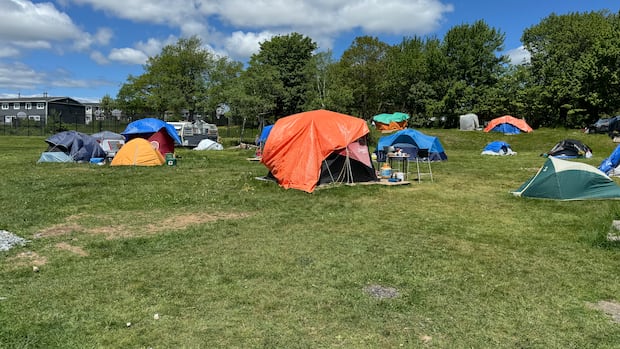Nova ScotiaHalifax will shift its approach to homelessness from emergency support for those sleeping rough to moving people indoors now that staff say there are consistently enough options for most people. Municipal staff say new spaces in shelters, supportive housing allow for changeHaley Ryan · CBC News · Posted: Nov 19, 2025 11:35 AM EST | Last Updated: 2 hours agoListen to this articleEstimated 6 minutesThe audio version of this article is generated by text-to-speech, a technology based on artificial intelligence.The designated homeless encampment off Green Road in Dartmouth is seen in June 2024. The site is one of two remaining designated encampments in HRM. (Galen McRae/CBC)Halifax will shift its approach to homelessness from emergency support for those sleeping rough to moving people indoors now that staff say there are consistently enough options for most people.On Tuesday, Halifax council unanimously voted for an updated homeless framework for 2026-28 brought forward by municipal staff. It includes closing the remaining two camps in Halifax and Dartmouth over the next two years, using data to help people more efficiently, and bringing in new rules of behaviour for people in those sites.“It will involve a lot of change for how we do our work, for the people who have come to rely on designated encampments,” said Rachel Boehm, executive director of community safety.“But we do know that it’s better for people to not live outdoors.” Ashton Stephenson, acting director of housing and homelessness for Halifax, left, and executive director of community safety Rachel Boehm speak to Halifax council on Tuesday. (Haley Ryan/CBC)Boehm said the landscape has changed dramatically since Halifax brought in its first framework in 2023 that set up designated encampments.While there were once more than 200 people sleeping outside, that has dropped to less than 100 now, Boehm said. She said about 45 of those people were in the designated sites as of last week, with others spread around the region.As of Nov. 12, there were about 67 available temporary indoor spaces at provincial communal shelters, Pallet shelters, tiny homes or other supportive housing environments, according to staff.Staff say the vast majority, more that 55, were in supportive housing, which are the most attractive because people can lock their own doors and have access to on-site support.“If there had been those open spaces in shelters, as there are now, we likely wouldn’t have moved to have the designated encampments,” Boehm said.There will also be new structure in the remaining encampments, Boehm said. Each person at a site will be registered and connected to an outreach worker, who will connect with services to find the best indoor option for them. The number of campers and size of sites will be better controlled, the report said.Coun. Virginia Hinch of Halifax Peninsula North asked how security will be improved. She said she has had many calls from residents near designated sites who say they don’t feel safe.Boehm said the municipality is bringing in contracts to manage the behaviour of people living at the encampments because rules are helpful for everyone in society in “fighting back the chaos and maintaining peace and quiet in our daily lives.”She said staff are hopeful this will improve safety for not only neighbours of the sites, but those forced to live in them, who are a wide variety of ages including youth and seniors.“I can’t imagine it won’t significantly alter [the situation] compared to now,” Boehm said.With fewer encampments, municipal staff can visit the sites more frequently during the day, Boehm said. The new mobilization team has made a difference responding to issues in and around camps on the evenings and weekends, Boehm said.Ashton Stephenson, acting director of housing and homelessness for Halifax, said his team is now connected to the homeless management information system used by shelters and other service providers. He said this makes helping people more efficient, and the municipal team can see where available indoor spaces are at all times.Halifax can now see where spaces are openBoehm said the new data allows them to know if someone has had issues in the past staying in certain types of shelters, so they try something new rather than doing the same thing “over and over and expecting a different outcome.”More complex cases of people who need various mental health or addictions support will be brought to case management tables with provincial representatives, Boehm said, which have been successful in finding unique solutions for people.As the camps close, Boehm said outreach staff will monitor the seasonal spike in more people sleeping rough when it’s warm outside, and be proactive about connecting them with indoor options right away.Halifax staff can ask people sheltering in inappropriate places, like near schools or on sidewalks, to move because there are now indoor places for them to go.“If there’s a big influx, well then we’ll go back, we’ll revisit things and re-think what we’re doing,” said Deputy Mayor Patty Cuttell.Coun. Sam Austin of Dartmouth Centre said he is supportive of the strategy as long as it remains driven by data, and focused on helping the most vulnerable people in society who are forced to sleep outside.He noted that when other Halifax designated sites closed, many people simply moved over to Dartmouth. The municipality had to reopen the site on Geary Street for a few months before closing it again this spring.Coun. Sam Austin speakers to reporters in this file photo. The Dartmouth councillor says he is optimistic about the new homeless strategy, but site closures must be done carefully. (CBC)“If we get into arbitrarily trying to close encampments to meet some sort of political … objective, that’s where we could go awry,” Austin said.A new shared statement of commitment with the provincial Department of Opportunities and Social Development is nearly done, Boehm said, which will lay out roles and responsibilities for each order of government when it comes to homelessness.Halifax Mayor Andy Fillmore said a closer partnership with the province has been an important change over the past year.”The provincial staff and municipal staff are working extremely well together, sharing data, weekly conversations. So all of that accounts for the success that we’re hearing today,” Fillmore told reporters.Although the number of people sleeping rough has dropped, overall homelessness is still going up. Boehm said it is expected to climb in the coming years, following the national trend.About 1,028 people and families in Halifax were on a list that tracks those in need of housing as of Sept. 10.MORE TOP STORIES ABOUT THE AUTHORHaley Ryan is the municipal affairs reporter for CBC covering mainland Nova Scotia. Got a story idea? Send an email to haley.ryan@cbc.ca, or reach out on Twitter @hkryan17.
New rules coming to Halifax homeless encampments, sites slated to close












